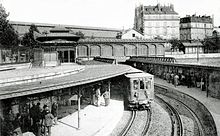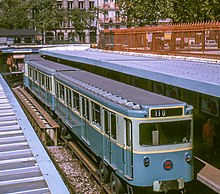Bastille (Métro Paris)
|
|
|
|---|---|

|
|
| Tariff zone | 1 |
| Line (s) |
|
| place | Paris IV , XI , XII |
| opening | July 19, 1900 |



Bastille is a transfer station of the Paris Métro . It is served by lines 1 , 5 and 8 . With 37,287 passengers on workdays , the underground station had the 12th largest number of passengers on the metro in 1998.
location
The metro station is located at the intersection of the borders of the 4th , 11th and 12th arrondissements of Paris . The station of line 1 is located south of the Place de la Bastille on the northern edge of the Bassin de l'Arsenal , where it crosses the Canal Saint-Martin at a right angle.
The station on line 5, which is in a north-south direction, is on the east side of the Place de la Bastille, parallel to the Canal Saint-Martin, which runs underground there. Its northern end is at the height of the July column , which stands in the middle of the square. Line 8 has its - the lowest - station east of the canal on the northern edge of the square. It is on the axis of the Rue du Faubourg Saint-Antoine .
Surname
The Place de la Bastille , located directly north of the station , a circular square on the site of the former city gate and later Bastille state prison , gave the underground station its name. During the construction of the line 5 station in 1905, remains of the foundation of one of the eight towers of this structure, which had been razed after it was stormed, were found. Their location is marked by a yellow line on the platform in the direction of Bobigny .
history
In the course of the construction of the station of Line 1, the Place de la Bastille was extended by 40 m to the south and the Canal Saint-Martin was capped up to the Bassin de l'Arsenal. A striking entrance structure designed by Hector Guimard was erected on and above the eastern head of the station .
The station was put into operation on July 19, 1900 with the opening of Line 1, which at the time ran from Porte Maillot to Porte de Vincennes . The station was moved slightly to the east in 1908 for traffic with Sprague-Thomson-type trains consisting of longer cars . The distinctive entrance structure designed by Hector Guimard over the tracks at the east end of this station was demolished in 1962. At the beginning of the 1960s, the station was again extended to the east and converted for traffic with six-car trains with rubber tires. Before 2012, as part of the introduction of driverless operation on Line 1, the platforms were raised and provided with platform screen doors.
When line 5 was extended from Place Mazas (since 1916: Quai de la Rapée ) to Lancry (since 1946: Jacques Bonsergent ), the line 5 station went into operation on December 17, 1906. On May 5, 1931, the station followed line 8, when the section from Richelieu - Drouot to Porte de Charenton of this line was opened at the beginning of the colonial exhibition in the Bois de Vincennes .
description
All stations are double-track and have side platforms. The station of line 1 is the only one above ground on this line, but it is also below street level. It has a length of 125 m, which is unusual for Paris, and can theoretically accommodate seven-car trains; the platforms are 4.10 m wide. The route crosses the Canal Saint-Martin there and leads back into tunnels on both sides. At the western end of the station (towards La Défense ), with a radius of 38 m, is the narrowest curve in the Paris metro network that is used by passenger traffic.
The stations of lines 5 and 8 are located under elliptical vaults with curved (line 5) or vertical (line 8) side walls. The station of line 5 has the Paris standard length of 75 m, that of line 8 was created from the beginning with a length of 105 m. Immediately to the west of its station, line 8 first crosses the Canal Saint-Martin and then the tunnel of line 5.
Because the stations are relatively far apart, there are long and branched access and transfer tunnels. The longest pedestrian tunnel is on the east side of the square in front of the Opéra Bastille , it connects the stations of lines 1 and 8. Two pedestrian tunnels cross the underground Canal Saint-Martin at the level of the south head of line 5 (connection 1/5) and immediately north of the July column (connection 5/8).
From the street there are eight entrances, some of which have the Art Nouveau decor designed by Hector Guimard or a candelabra designed by Adolphe Dervaux in the Art Deco style .
Art Nouveau entrance on Boulevard Beaumarchais designed by Hector Guimard
vehicles
Initially wrong on Line 1 trains consisting of a motor coach 2nd class with only one cab , a sidecar were second class and a sidecar first class. These vehicles were two-axle and each nearly nine meters long. As early as 1902, eight-car trains were formed, which consisted of six trailer cars and one railcar at each end of the train. By 1905, the railcars were replaced by four-axle vehicles that rested on bogies . From 1906, there were also sidecars on bogies, the six-car trains from then on consisted of three multiple units and three sidecars. In 1908, green painted five-car trains of the Sprague-Thomson design entered Line 1, which stayed there until the 1960s. From May 1963, the Sprague-Thomson trains, which ran on rails, were successively replaced by the rubber-tyred vehicles of the MP 59 series, until December 1964, mixed traffic of the two modes of operation prevailed. The MP 89 CC series followed in 1997, which gave way to the MP 05 series with the start of automatic operation .
The Sprague-Thomson trains on line 5 were replaced from 1978 by vehicles from the MF 67 series , which were followed by MF 01 trains from 2011 .
During the colonial exhibition in 1931, seven-car trains of the Sprague-Thomson design ran on line 8. Later the train lengths were shortened to five cars. From 1975 onwards, MF 67 trains came on the line, which were replaced by the MF 77 series from 1980 .
Surroundings
- Place de la Bastille with the July column
- Opéra Bastille on the site of the former Gare de la Bastille train station
- Port de l'Arsenal in the Bassin de l'Arsenal
- Coulée verte René-Dumont (Promenade plantée), park on a disused railway viaduct
Remarks
- ↑ This made it possible to avoid the stop of the first or last car in the tight curve at the west head - and thus large gaps between the platform edges and the car doors
- ^ After the metro accident at Couronnes station in August 1903, both railcars ran one behind the other at the Zugspitze
- ↑ In contrast to the other lines, the trains on line 1 were light gray from the early 1930s (with the red 1st class car)
- ↑ CC means "Conduite Conducteur" (driver-controlled), in contrast to the driverless type MP 89 CA
- ↑ Because the stations of line 8 to the west of Richelieu - Drouot were initially only 75 m long, the last two wagons of a train continued to run empty from there, as they did not reach the edge of the platform
Web links
- Entrée du métropolitain - Bastille station with photos of the access structure designed by Hector Guimard
literature
- Gérard Roland: Stations de métro. D'Abbesses à Wagram . 2003, ISBN 2-86253-307-6 .
Individual evidence
- ↑ Jean Tricoire: op. Cit. P. 342.
- ↑ a b c Jean Tricoire: Un siècle de métro en 14 lignes. De Bienvenüe à Météor . 2nd Edition. La Vie du Rail, Paris 2000, ISBN 2-902808-87-9 , p. 142 .
- ^ Gérard Roland: Stations de métro d'Abbesses à Wagram . Christine Bonneton, Clermont-Ferrand 2011, ISBN 978-2-86253-382-7 , pp. 211 .
- ↑ a b Jean Tricoire: op. Cit. P. 130.
- ↑ Jean Tricoire: op. Cit. P. 128.
- ↑ Jean Tricoire: op. Cit. P. 133.
- ↑ Jean Tricoire: op. Cit. P. 73.
- ↑ Jean Tricoire: op. Cit. P. 134.
- ↑ Jean Tricoire: op. Cit. P. 197.
- ↑ a b Jean Tricoire: op. Cit. P. 241.
- ^ A b Brian Hardy: Paris Metro Handbook . 3. Edition. Capital Transport Publishing, Harrow Weald 1999, ISBN 1-85414-212-7 , pp. 36 .
- ^ Christoph Groneck: Metros in France . 1st edition. Robert Schwandl, Berlin 2006, ISBN 3-936573-13-1 , p. 10 .
- ↑ Jean Tricoire: op. Cit. P. 132 ff.
- ↑ Jean Tricoire: op. Cit. P. 198.
| Previous station | Paris metro | Next station |
|---|---|---|
|
Saint-Paul ← La Defense |
|
Gare de Lyon Château de Vincennes → |
|
Bréguet - Sabin ← Bobigny - Pablo Picasso |
|
Quai de la Rapée Place d'Italie → |
|
Chemin Vert ← Balard |
|
Ledru-Rollin Pointe du Lac → |
Coordinates: 48 ° 51 '11.6 " N , 2 ° 22' 8.8" E







